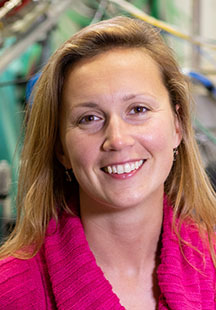Diana Gamzina: Improving X-ray technology using X-rays
 Diana Gamzina came to SLAC from the University of California, Davis, where she earned bachelor’s degrees in mechanical engineering and materials science, a master’s degree in mechanical engineering and a PhD in mechanical and aerospace engineering. At Davis, she also worked as a principal development engineer, focusing on R&D of high-frequency RF sources. She joined SLAC’s Technology Innovation Directorate as a staff scientist in January 2017.
Diana Gamzina came to SLAC from the University of California, Davis, where she earned bachelor’s degrees in mechanical engineering and materials science, a master’s degree in mechanical engineering and a PhD in mechanical and aerospace engineering. At Davis, she also worked as a principal development engineer, focusing on R&D of high-frequency RF sources. She joined SLAC’s Technology Innovation Directorate as a staff scientist in January 2017.
She will use her award to study how powerful RF radiation causes materials to fail. The ultimate goal: develop materials that better withstand radiation damage.
RF technology is at the heart of a number of important applications. RF sources, for example, are key components of modern communications systems on Earth and in space. And in particle accelerators, RF fields boost the energy of particle beams used in “super-microscopes” that reveal nature’s fundamental building blocks, in medical devices for radiation cancer therapy, and in ultrabright X-ray light sources like LCLS that “film” atoms as they rapidly jiggle in materials.
Making RF devices smaller and more powerful could shrink accelerators, make radiation therapy more effective in killing cancer and make it easier to fit powerful RF emitters into satellites, for instance. But packing more power into smaller and smaller RF structures can break down materials.
“A large portion of my work has been trying to develop RF devices that fit in the palm of your hand but are still powerful enough for potential applications,” Gamzina said. “Before we can be truly successful, we need to understand what makes materials fail under high RF power densities.”
Researchers have been asking this question for many, many years, she said, and until now nobody has been able to determine what exactly happens to the structure of materials on a microscopic scale when they degrade under those conditions. Gamzina’s Early Career Award project aims to change that.
In a first step, she will use a new, unique RF-pump X-ray probe instrument at SLAC’s Stanford Synchrotron Radiation Lightsouce (SSRL) to look at microstructural changes in materials hit by RF pulses. Then, in collaboration with Lawrence Livermore lab, she’ll develop theoretical models based on the SSRL data to explain why materials respond in certain ways to RF radiation. The goal is to find new ways of making materials 10 times more robust in the face of high-power RF fields.
The studies will focus on copper and niobium, metals that are widely used for RF applications. At SLAC, a 2-mile-long linear accelerator made of copper and operating at room temperature has been instrumental for a long, successful research history. Today, one-third of that linac drives the generation of X-rays in LCLS. Another third is being replaced with a superconducting accelerator using niobium components that will operate at about the same temperature as outer space and enable the LCLS-II upgrade to fire X-rays up to a million times per second.
“Looking at two materials sounds easy, but it’s actually much more challenging than it sounds,” Gamzina said. “There isn’t just one form of copper or one form of niobium. There are many variations for both metals. Copper can have many different microstructural states that affect its behavior, and the superconducting properties of niobium depend on its surface properties, impurities and so on.” For the niobium work, Gamzina will collaborate with DOE’s Fermi National Accelerator Laboratory, one of the national labs building superconducting accelerator structures for LCLS-II.
What excites her most about this research is that it’s very complex, bringing multiple aspects of physics and engineering together to explain a fundamental phenomenon in materials science. SLAC is a great place to make all these connections, she said.
“We’re a leader in the development of RF sources, we have extremely strong expertise in copper accelerators and we’re expanding our expertise in superconducting technology. And then we have a tool like SSRL, which uses a lot of that technology and expertise to generate powerful X-rays,” she said. “My project connects these things: We’ll be using our own tool – SSRL – to better understand and improve the devices – RF sources and accelerator structures – that make our tools possible in the first place.”
LCLS and SSRL are Office of Science user facilities.
For questions or comments, contact the SLAC Office of Communications at communications@slac.stanford.edu.
